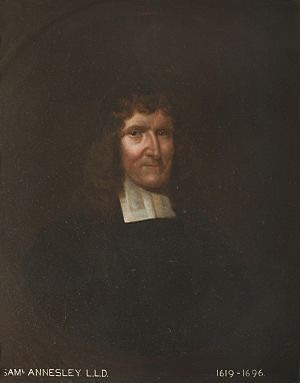Samuel Annesley facts for kids
Samuel Annesley (born around 1620 – died 1696) was an important Puritan minister. Puritans were a group of Christians who wanted to make the Church of England simpler and more "pure." Annesley was also a nonconformist, meaning he didn't follow all the rules of the official Church of England. He is most famous for the collection of sermons he put together called Morning Exercises.
Contents
Early Life and Education
Samuel Annesley was born in Haseley, a town in Warwickshire, England, in 1620. His parents were John and Judith Annesley. Sadly, his father passed away when Samuel was young. Even as a child, Samuel loved to read the Bible.
In 1635, he started studying at The Queen's College, Oxford, a famous university. He earned his first degree in 1639. By 1642, he was allowed to preach, sharing his religious messages in Chatham. He became a minister in the Presbyterian Church in 1644. He also worked as a chaplain, a kind of minister, for Robert Rich, 2nd Earl of Warwick. The Earl was a leader of the Parliament's navy during the English Civil War.
A Time of Change in England
During this time, England was going through a lot of political and religious changes. There was a big conflict between the King and Parliament. Samuel Annesley took over as minister in Cliffe, Kent, after the previous minister was removed for supporting the King.
In 1648, he gave a sermon to the House of Commons, which was a very important part of Parliament. Around this time, Oxford University gave him an honorary doctorate degree. He also spent more time at sea with the Earl of Warwick, who was fighting against the King's navy.
Samuel Annesley did not agree with the execution of King Charles I. He also had a low opinion of Oliver Cromwell, who became a powerful leader in England. Because of his views, Annesley lost his position in Cliffe. In 1652, he became the minister at St John the Evangelist in Friday Street, London.
Challenges and Continued Preaching
In 1657, Oliver Cromwell chose Annesley to be a lecturer at St Paul's Cathedral. Later, in 1658, Cromwell's son, Richard Cromwell, appointed him to be the vicar of St Giles, Cripplegate.
After the King returned to power in 1660 (this was called the Restoration), Samuel Annesley was still the vicar at St Giles. However, in 1662, a new law called the Act of Uniformity 1662 was passed. This law required all ministers to follow strict rules of the Church of England. Because Samuel Annesley was a nonconformist, he was "ejected" or removed from his church position. This event was part of what is known as the Great Ejection.
Even after being removed, Annesley continued to preach in private meetings called "conventicles." These meetings were against the law at the time. His belongings were sometimes taken away as punishment for holding these meetings. In 1669, he was preaching in Spitalfields to a large group of about 800 people!
In 1672, the King issued a "Declaration of Indulgence," which allowed nonconformists to preach legally. Annesley was licensed as a Presbyterian teacher. But when the Declaration was cancelled in 1673, his license was taken away, and more of his property was seized. Despite these difficulties, he kept supporting other nonconformists and continued to preach in London. He was known for his powerful sermons, which were described as very practical and connected to people's daily lives.
Influence on Daniel Defoe
Samuel Annesley had a big influence on the famous writer Daniel Defoe. Defoe, who wrote Robinson Crusoe, was a member of Annesley's church. Annesley would often ask Defoe to take notes during his sermons and then try to remember and write down the whole message. This practice likely helped Defoe develop his writing skills. In 1697, Defoe even wrote a poem about Dr. Samuel Annesley after he passed away.
Death and Legacy
Samuel Annesley died on December 31, 1696. His funeral sermon was given by another minister, Daniel Williams. Daniel Defoe wrote a poem about Annesley's death, which included these lines:
- The sacred bow he so divinely drew,
- That every shot both hit and overthrew;
- His native candour and familiar style,
- Which do so often his hearers' hours beguile,
- Charmed us with godliness, and while he spake,
- We loved the doctrine for the speaker's sake.
And also:
- A Pleasing Smile sate ever on his brow
- A sign that chearful Peace was lodged below,
He was buried in St Leonard's churchyard in Shoreditch, but his grave does not have a marker.
Annesley had a very large personal library of books. After he died, his books were sold at an auction in London in 1697. The list of books for sale included over 1,200 different items!
Works
Samuel Annesley's writings were mostly sermons that were published separately. He also helped put together and edited several collections of sermons called Morning Exercises at Cripplegate. These books featured sermons from many important Puritan ministers who discussed everyday problems and questions of faith. Annesley wrote the first sermon for each of these important collections. He also wrote some biographical works, including a life story of Thomas Brand.
Family
Samuel Annesley married Mary Hill in London in 1641. They had a son named Samuel, but both Mary and their son passed away when they were young.
Annesley later married again, though the record of this marriage is not clear. He had a large family with his second wife, and at least nine of his children lived to adulthood. One of his daughters, Elizabeth, married a man named John Dunton. Another daughter, Susanna Wesley, became the wife of Reverend Samuel Wesley. Susanna and Samuel Wesley were the parents of John Wesley and Charles Wesley, who later founded the Methodist movement, a very important branch of Protestant Christianity. Annesley's eldest son, also named Samuel Annesley, worked for the East India Company in India.
Images for kids



